Analogy: Definition & Meaning (with Examples)
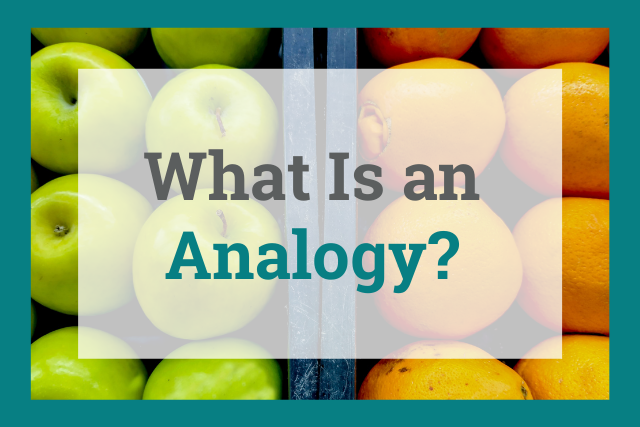
Analogy is one of the most common types of literary devices. It's also one of the hardest to understand because it's similar to other types of figurative language. Today, we're going to dive into the meaning of analogy with in-depth explanations and examples.
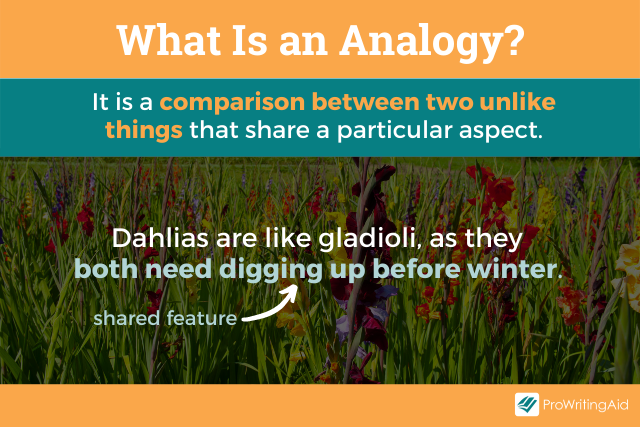
Analogy Definition: What Is an Analogy?
Let's start with the dictionary definition of an analogy. According to Merriam-Webster, an analogy is "a comparison of two otherwise unlike things based on a resemblance of a particular aspect."
We use analogies all the time in speaking and fields like history and science. They help us illustrate a point that might be hard to comprehend. For example, we might make an analogy between the Trail of Tears of U.S. History and the Jewish Diaspora of World History. In biology, you might discuss the analogous relationship of bat wings and bird wings.
As a literary device, however, analogy's meaning has more nuance that separates it from other types of rhetorical devices. Let's look at the literary meaning of analogy in more detail in the next section.
Analogy Meaning
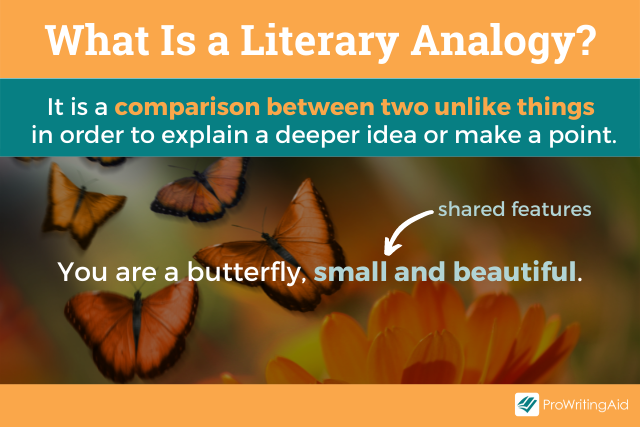
As a rhetorical device, analogy compares two unlike things with the purpose of both illustrating a comparison and explaining it. You aren't just trying to show a similarity when you use an analogy. You are also trying to make a point about this similarity.
Analogies can be useful to explain complex concepts by comparing them to a familiar idea. Analogies also help paint a picture in a reader's mind and add emphasis to important ideas in writing.
Let's take a look at a popular example of an analogy from the movie Forrest Gump. In the movie, Forrest says that his mother always told him, "Life is like a box of chocolates—you never know what you're gonna get."
If Forrest just said that life was like a box of chocolates, we would wonder what the similarity is. What point is he trying to get across? It might be that life is sweet or that life is a gift from someone who loves you. But then he explains that we never know where life will take us or what circumstances we will fall into. We don't know until we get there; we can't see the future.
He's not just painting a picture about life. He's making a point about the uncertainty of life and the many twists and turns it takes. This analogy goes further and illustrates the entire premise of the film. Forrest goes from being a boy in leg braces to an international ping pong champion to a dad. No one could have predicted that!
Analogies look similar to other types of figurative language. So, what's the difference?
Analogy vs. Metaphor
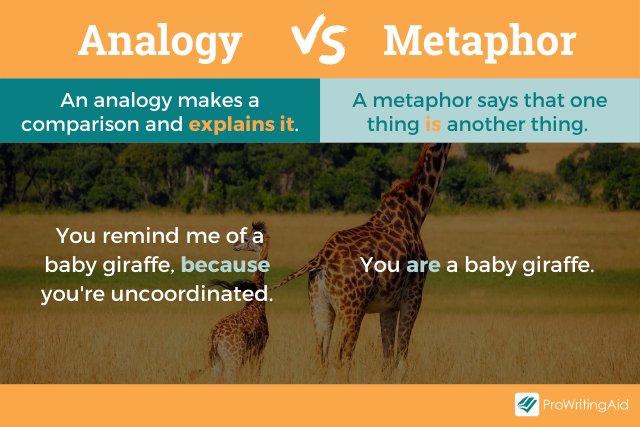
A metaphor is a figure of speech that shows a likeness between two otherwise different things. The point of a metaphor is comparison. For example, we can say, "the kids were a bunch of monkeys today." We are comparing kids to monkeys.
An analogy not only compares but explains. "The kids were a bunch of monkeys today, climbing all over the furniture, running all over the house, and shrieking."
As you can see, an analogy might feature a metaphor, but it goes further in making a point. This is also different from an extended metaphor. An extended metaphor continues to use a comparison to illustrate similarities of two objects. An analogy requires some explicit explanation to make its point.
Analogy vs. Simile
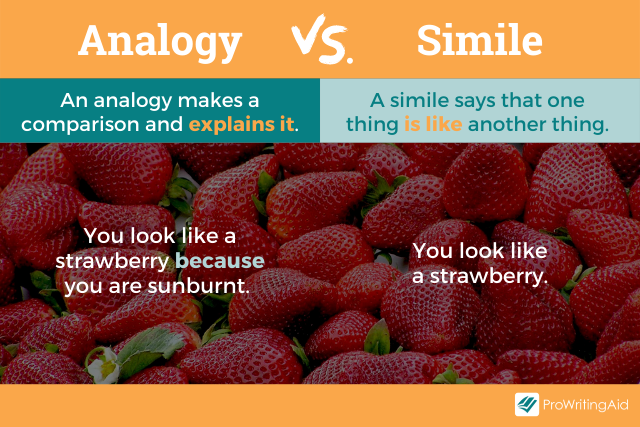
A simile is a type of metaphor, but it uses "like" or "as" to draw comparisons. Just like with a metaphor, an analogy might use a simile to compare two things, but then the analogy goes on to explain the idea behind it.
The Forrest Gump quote is an example of this. The part of the quote, "Life is like a box of chocolates," is a simile. The next part of the quote that tells how life and a box of chocolates are related is what makes this quote an analogy.
Many analogies use similes and metaphors to make comparisons, but it is not required.
Analogy vs. Allusion
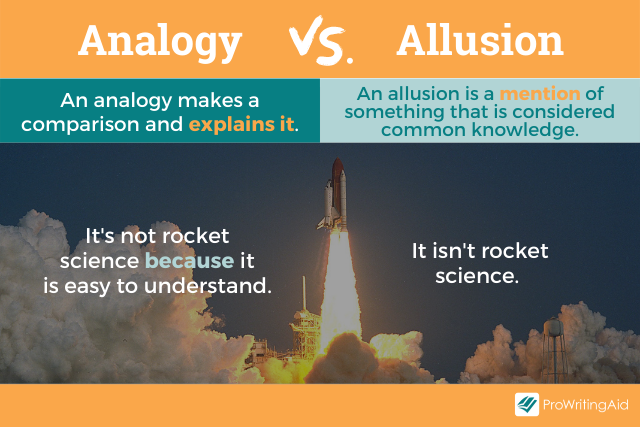
Another figurative language element that is easy to confuse with analogy is allusion.
Allusion is a mention of a person, place, or thing that is considered common knowledge. It's often a reference to a famous person or event or a well-known story, like fairy tales, myths, or religious parables.
Allusion is a way to compare two things. Let's look at an example:
- "The books on the top shelf were forbidden fruit."
Forbidden fruit refers to the fruit of the Tree of Knowledge in the Bible. This is an allusion. We can draw enough conclusions from this allusion to understand what the books represent.
Allusions can be part of analogies, too. Remember, where allusions compare, analogies explain:
- "If the library was Eden, the books on the top shelf were forbidden fruit. They opened my eyes to a world beyond the life I had always known."
All of these are useful types of figurative language. The difference lies in the purpose. If the goal is to explain an idea or get a specific point across, it's an analogy.
Analogies, Idioms, and Clichés
Sometimes analogies become so well-known that they become part of our everyday lexicon. Idioms are phrases that don't make sense literally, but they do make sense figuratively. Overused idioms can become clichés.
An example of an analogy that is a cliché is "she's as blind as a bat." It's a very overused comparison. Use ProWritingAid's Clichés Report to help identify the clichés and idioms in your writing. While some common analogies might help you get your point across, some can actually hinder your writing's clarity, especially to non-native speakers.

Try the Cliché Report with a free ProWritingAid account.
Analogy Examples
You probably hear or read analogy examples all the time—they're a common rhetorical device. Today, we'll take a look at some analogy examples from everyday sentences and literature.
Examples of Analogy in a Sentence
Humans love figurative language, and we create analogies in our everyday speech. Here are some examples.
- Ordering clothes online is like playing the lottery. Some fit great, and some are a complete waste of money when they don't even go over your head!
- His voice was warm honey on toast, sweet and comforting and familiar.
- She thought the sound of babies crying was as annoying as fingernails on a chalkboard. Babies definitely weren't for her.
Can you create any analogies?
Examples of Analogy in Literature
Analogy is a powerful rhetorical device. Here are some famous examples of analogy in literature:
- "All the world’s a stage / And all the men and women merely players / They have their exits and their entrances / And one man in his time plays many parts / His acts being seven ages."—As You Like It, William Shakespeare
- “I can admire the perfect murderer—I can also admire a tiger—that splendid tawny-striped beast. But I will admire him from outside his cage. I will not go inside . . . . That is to say, not unless it is my duty to do so. For you see, Mr. Shaitana, the tiger might spring . . . .”—Cards on the Table, Agatha Christie
- "Memory is to love what the saucer is to the cup."—The House in Paris, Elizabeth Bowen
Tips on How to Write an Analogy
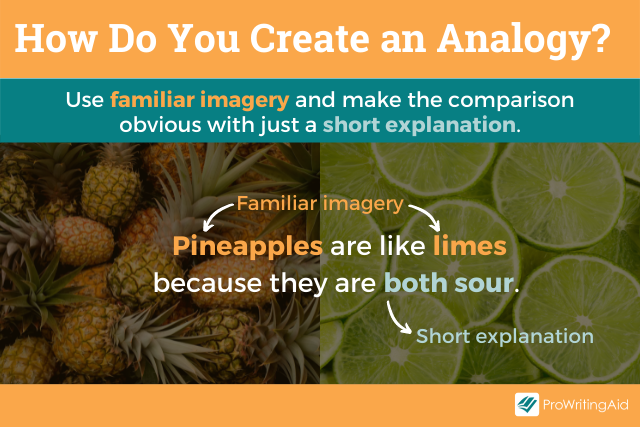
When you're writing an analogy to express an idea, it's important to keep two things in mind. First, make sure that at least one of the two things you're comparing is familiar and easy to understand. An analogy should make your point clear to the reader, not leave them confused! Animal or nature imagery, allusions to well-known tales, and everyday objects are good things to use in your analogies.
Secondly, make sure that your comparison is clear without much explanation. If you compare a shy, demure princess to a tiger, you need to explain what specific aspects of the princess and the tiger are similar. Is she ferocious when her loved ones are attacked? Does she prefer to spend time alone outdoors and seethe when caged?
If it takes too many sentences to explain the analogy, try using different imagery that is simpler to understand.
Different Types of Analogy
There are two main types of analogy. These are based on how closely related the two things being compared are.
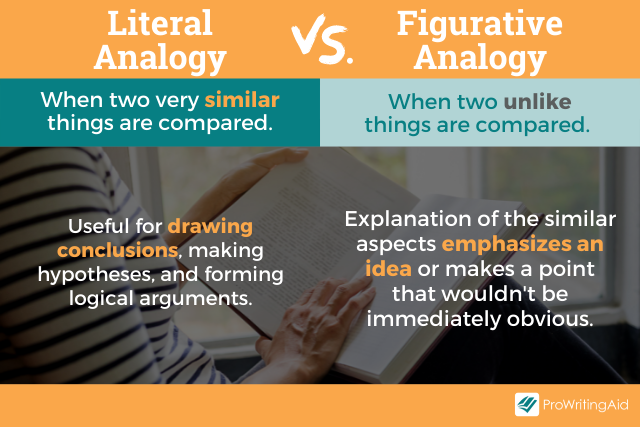
Literal Analogy
The first type of analogy is a literal analogy. When two things are very closely related, we compare them with literal analogies. These are the types of analogies commonly used in science. Literal analogies can help scientists draw comparisons or make a logical argument.
For example, a virologist might compare the viral structure of two different viruses. If the virus has a similar structure and similar symptoms to another, they are analogous. This will help them theorize that the second virus can be treated similarly to the first.
Literal analogies don't have to be just for science! If you're a baker, you might know that you can make a cheesecake out of either cream cheese or mascarpone. As an analogy, we can say that mascarpone is a lot like cream cheese. They both have high fat content, are very soft, and are not aged.
Literal analogies are the type you might see on standardized tests. They used to feature on the SAT and looked like this: A:B::C:D. You can read literal analogies as "A is to B as C is to D."
Here's a simple example:
- Night is to sleep as morning is to wake.
Standardized tests would have one or more of the words blank, and you had to determine the connection in the analogy. How are they connected?
Figurative Analogy
A figurative analogy makes a comparison between two or more things that aren't necessarily that similar at first glance. The analogy focuses on making a comparison based on a specific aspect of the unrelated things. This is called shared abstraction.
Take a look at the following analogy:
- "Giving candy and coffee as appreciation gifts is just rearranging deck chairs on the Titanic. It's not actually fixing the issues that are causing low morale, like low pay, long hours, and micromanaging."
If the Titanic is sinking, it's pointless to rearrange deck chairs. Likewise, this quote suggests spending money on little gifts is pointless because it's not addressing the real issues at hand that are causing employee dissatisfaction.
No one is suggesting that low morale at a company is the same thing as the hundreds of lives lost on the Titanic. The shared abstraction is doing something pointless in the face of a disaster.
Should You Use Analogies in Your Writing?
Analogies are powerful literary devices because they create an image in the reader's mind while making a point in a deeper way than a metaphor. Remember, an analogy compares two objects with the purpose of explaining a deeper idea. A literal analogy compares two very similar objects, while a figurative analogy relies on shared abstractions.